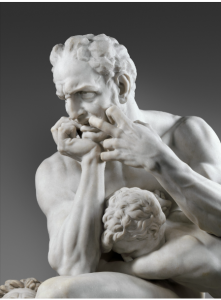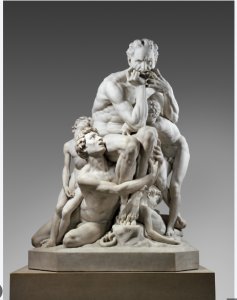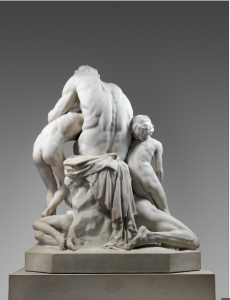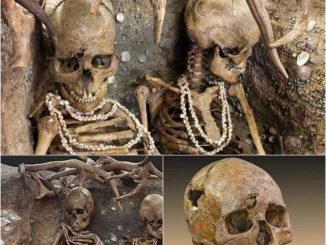A Masterpiece of Emotion and Detail
In the heart of the art world, where emotion and marble converge, stands “Ugolino and His Sons,” a sculpture that transcends time and narrative to speak directly to the soul. Crafted between 1865 and 1867 by Jean-Baptiste Carpeaux, this masterpiece captures a moment of profound despair and familial bonds, drawing from Dante Alighieri’s “Inferno.” This blog post delves into the stunning details of Carpeaux’s work, inviting readers to explore the depth of its artistry and the ancient discoveries that illuminate its historical significance.

The Story Cast in Stone
“Ugolino and His Sons” illustrates the tragic tale of Count Ugolino della Gherardesca, imprisoned with his sons and grandsons and left to die of starvation. Carpeaux’s sculpture is a vortex of emotion, each figure wrapped in an agonizing dance of despair. The count’s figure, central and dominating, is caught in a moment of contemplation, his face etched with the weight of impending doom and paternal sorrow. Surrounding him, his sons and grandsons display varying degrees of understanding and reaction to their fate, from resigned despair to naive unawareness.

A Symphony of Details
Carpeaux’s genius shines in the sculpture’s minutiae. The tension in Ugolino’s muscles, the veins on his forearms, and the expressive despair on his face are rendered with breathtaking realism. The interplay of textures, from the smoothness of skin to the roughness of the prison garb, showcases Carpeaux’s mastery over marble. Light and shadow dance across the sculpture, highlighting the dramatic intensity of the scene and inviting viewers to lose themselves in its tragic beauty. Images of these details are crucial for appreciating the sculpture’s depth, encouraging an exploration of the physical and emotional nuances captured by Carpeaux.

The Echoes of Ancient Tragedy
Carpeaux’s work does not exist in isolation; it is a mirror reflecting the human condition throughout history. The sculpture’s theme of suffering and paternal love finds echoes in ancient myths and tragedies, from the trials of Prometheus to the sacrifices of Agamemnon. These stories, like “Ugolino and His Sons,” explore the depths of human despair and the complexities of moral and emotional dilemmas. Recent archaeological discoveries, shedding light on ancient societies, underscore the universality of these themes. Unearthed artifacts and ruins reveal cultures grappling with the same existential questions that Carpeaux explores, bridging the gap between past and present, and highlighting the enduring nature of human emotion and conflict.

Conclusion: A Testament to Timeless Artistry and Human Experience
Jean-Baptiste Carpeaux’s “Ugolino and His Sons” is more than a sculpture; it is a profound commentary on the human condition. The detailed rendering of each figure, the emotional depth captured in marble, and the historical resonance of the depicted tale, all contribute to the sculpture’s enduring appeal. As we encourage readers to view images of this masterpiece and reflect on the ancient discoveries that connect us to our past, we are reminded of the power of art to evoke empathy, to transcend boundaries, and to explore the depths of human despair and resilience. Carpeaux’s work stands as a testament to the timeless artistry and the complex tapestry of human experience, inviting us to confront our darkest fears and find beauty in the midst of suffering.

As we delve into the history of art and its ancient discoveries, works like Carpeaux’s remind us of art’s enduring ability to capture the complexities of the human heart and the timeless struggles that unite us across ages. “Ugolino and His Sons” stands not merely as a monument to Carpeaux’s skill but as a testament to the profound impact art can have on our understanding of ourselves and the bonds that define our humanity.


